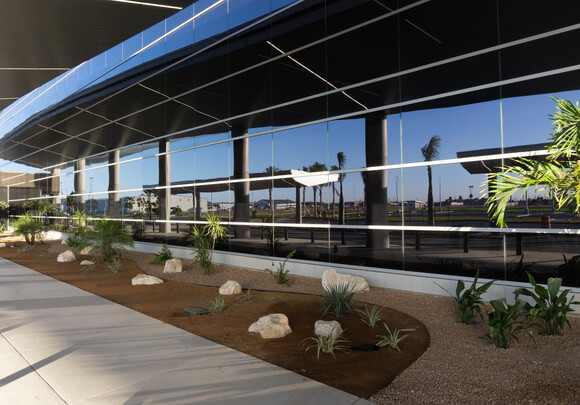Brownsville South Padre Island Intl Airport
The Challenge
In 2014, Brownsville, Texas was on the cusp of a new era: spacecraft engineering company SpaceX had announced that it would construct a new launch facility just a few miles away. As the new site took shape, the Brownsville South Padre Island International Airport (BRO) was bursting at the seams with visitors, business travelers, and new residents flowing into the region. The existing terminal, originally dedicated in 1929, was outdated, inefficient, and too small.
Architecture firm Corgan designed a new $79-million-dollar passenger terminal, including four gates, to replace the outdated space. The project team wanted to meet current and future demand, increase passenger capacity, and improve the terminal experience for both passengers and employees. Like most terminals and high-traffic airport areas, the new space would be made up mostly of glass. Conscious of the need to manage energy costs and keep people cool and comfortable, the BRO team looked for a smart glass solution that would minimize heat and glare while letting in plenty of daylight and outdoor views.
The Solution
To help make its modern terminal a reality, the BRO design team chose SageGlass Classic windows for over 13,000 square feet of glass. The smart windows tint automatically in response to the sun, keeping the terminal cool and reducing glare, even when outdoor temperatures are near 100° Fahrenheit.
Site constraints at the airport meant the building would be oriented with the major terminal facades facing east-west. "We knew from the onset that controlling the early morning and late afternoon sun would be a challenge," said Erik Strain, vice president of Corgan, the project's architecture firm. "By incorporating SageGlass into the design, we were able to improve thermal and glare control while giving the owner flexibility to control the tinting to meet their unique daily needs.”
Employees and passengers can read screens without squinting, sit near the windows without sweating, and still enjoy plenty of natural light—all without the need for traditional blinds or shades.
In fact, to quantify the benefits of the new smart windows, the BRO and SageGlass teams planned a study over the course of two weeks. During the first week, the smart glass was turned off. During the second week, it was turned on. Survey respondents—160 travelers, airport employees, and Transportation Security Administration (TSA) personnel—answered questions about their experiences in the new terminal. Weather conditions were consistent and comparable between the two weeks, ensuring that weather and amount of daylight weren't responsible for any differences between week-one and week-two survey responses.
The Benefits
The study found that, when the SageGlass windows were turned on, respondents were between two and three times more likely to be satisfied with thermal comfort, daylight, and glare control. With the smart windows turned off, travelers reported discomfort sitting next to windows; employees needed to use personal fans to stay cool; and many people needed to squint or use sunglasses to see their screens or the people around them.
Ensuring a positive passenger experience can also improve an airport's bottom line. Results from a 2016 study by the Airports Council International suggest that airport passengers spend more money when they're in an enhanced-comfort environment; a 1-percent increase in customer satisfaction can lead to a 1.5-percent increase in non-aeronautical revenue.
In addition to improving the passenger and employee experience, SageGlass windows are a key part of a greener building. BRO found that the SageGlass windows resulted in an energy savings of 26.8% (comparing July 2021 to July 2022).
Brownsville assistant city manager and airport director Bryant Walker said, " It's a top priority for us to provide a comfortable space for travelers and workers at the airport. Workers and travelers alike need to be able to interact without distractions from the heat, glare, or brightness coming from the windows surrounding them."



